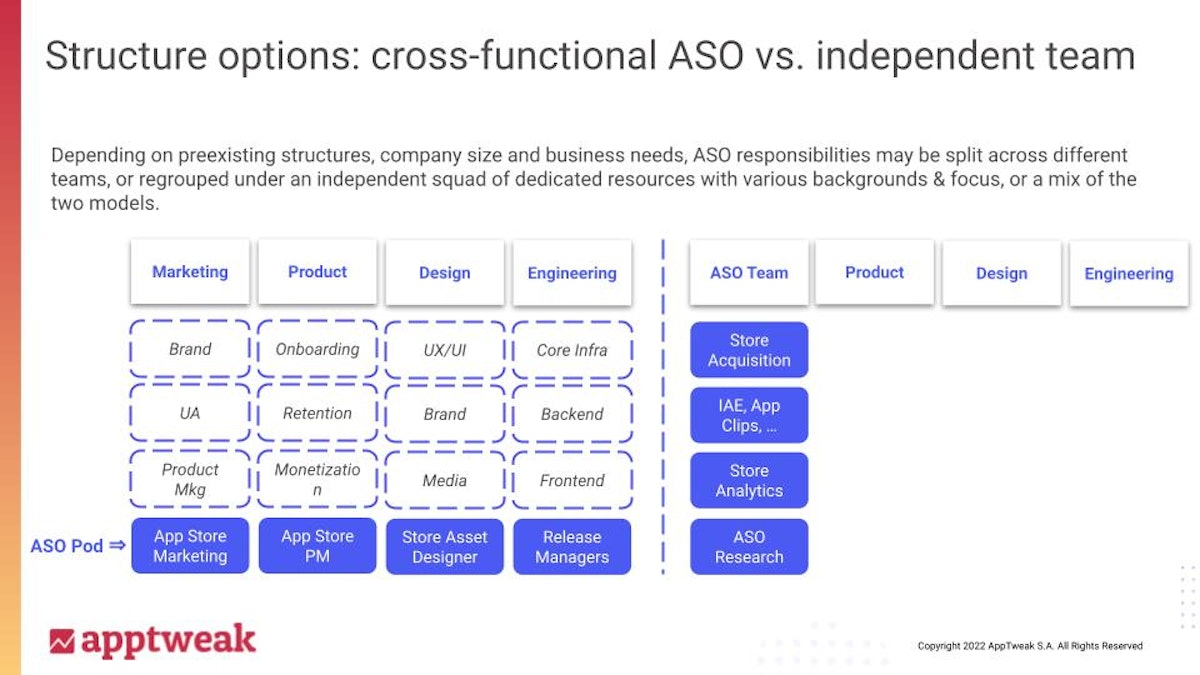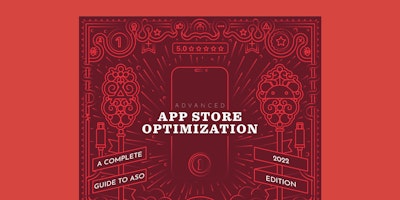
How to Build & Structure a Powerful ASO Team for Your App
With the increasing interest in App Store Optimization in recent years, more and more ASO positions have begun to appear within companies publishing one or more apps. This trend became particularly strong after Apple’s release of the App Tracking Transparency (ATT) and iOS 15.
These two events have led many to reconsider their user acquisition (UA) strategies, moving from approaches that focus heavily on paid advertising (e.g., social media and other methods relying on digital identifier tracking) to more privacy-friendly approaches that leverage organic acquisition and app store marketing tools. As such rapid change unfolds, a major challenge for most app companies is building an ASO team that fits their specific needs and can help unlock growth. Read on to learn how!
Identify how ASO fits within your organization
Before you start hiring for ASO roles, the first challenge is to identify where to insert ASO within your organization. Consider how recent features and changes introduced with iOS 15 or on Google Play have reshaped the potential of ASO and its implications, meaning that even companies that have already integrated ASO into their organizations may need to adjust how they combine it with the rest of their structure moving forward.
Historically, we’ve observed that most companies get started with ASO by assigning it as a secondary topic for their (paid) UA team or, in some instances, combining ASO and SEO (and sometimes SEA) as the focus of a role dedicated to “search” or “organic” acquisition. This then leads some to create full-time positions dedicated to ASO, usually within the UA team. Alternatively, we have also seen some companies make ASO a sub-task for their product teams, seeing how it relates to app updates on the App Store and Google Play.
Overlooking ASO is one of the biggest mistakes a UA manager can make!
Both options have their merits given that ASO is adjacent to these teams’ core functions; however, they have also fostered a tendency to limit ASO itself and the ability of an ASO manager to operate outside the functions of their assigned team.
Understanding the role of ASO
This is where major shifts on both app stores are likely to represent pain points for many organizations:
- The advent of iOS in-app events and promotional content on Google Play have turned the app stores into places to promote specific content to new, active, and/or lapsed users. This thus shifts the role of ASO from a singular focus on new user acquisition to a larger scope that covers acquisition, engagement, and retargeting.
- Simultaneously, the release of custom product pages with iOS 15 marked a turnaround from the “one store page for all” approach and now requires ASO to address how to best support user segmentation, from user research to the execution and measurement of app-specific marketing.
Adding to consideration topics like user review management (e.g., how to prompt users to leave positive reviews) or in situ discovery using iOS App Clips, it is evident that the scope of App Store Optimization has expanded to incorporate tasks managed by either marketing, product, data, or engineering teams, or even multiple departments at the same time.
 How ASO tasks fit within multiple positions of the growth spectrum defined by Andrew Chen (Source: Reforge + AppTweak).
How ASO tasks fit within multiple positions of the growth spectrum defined by Andrew Chen (Source: Reforge + AppTweak).
ASO team structures
Companies looking to maximize their ASO potential should consider addressing ASO as a subset of growth and decide on a structure to best manage it just as they would with growth. There are two opposing structures that may help inspire your choice:
1. Cross-functional roles dedicated to ASO
One or more roles in charge of ASO inserted in each company department (though not necessarily solely focused on ASO). This structure allows each role to seize opportunities linked to their respective field and coordinate with other ASO-focused employees as a “pod” scattered across multiple teams.
Advantages:
- Focus on defined missions with clear KPIs (e.g., user acquisition, measured by total new user downloads in store consoles)
- Possibility to combine ASO with other tasks (e.g., having one ASO product manager also in charge of promotional content or additional in-app/game content releases)
Challenges:
- Slower speed of projects that require multiple skills (e.g., combining insights from data and design to prioritize and execute new custom product pages)
- Ownership of functionalities outside the scope of ASO employees (e.g., initiating an App Clip test when no engineer is part of the ASO pod)
2. An independent team for all things “ASO”
Setting up a full team dedicated to all things ASO that takes ownership of all projects related to the app stores. This structure incorporates a team independent from other departments, drawing on employees from different backgrounds and with varying experiences who can each bring their expertise to ASO projects.
Advantages:
- Stronger alignment & faster execution of multi-skill projects
- Adaptability to new store functionalities and changes
Challenges:
- Prioritization of projects within the team (e.g., deciding whether to focus first on in-app events or custom product pages)
- Importance of ASO among business priorities (e.g., having a multi-skilled team fully dedicated to ASO will be more crucial for an app publisher managing a large portfolio of apps than for a business centered on a single app where focus may sometimes fully lie outside of ASO topics)

Two opposing structures when building an ASO team.
Read this case study on how Product Madness improved ASO processes & workflows within a month
Look for skills common within powerful ASO teams
The structure your company decides to adopt will impact (at least, partially) the profiles you select to lead your ASO projects. Once again, your needs will depend on your overall strategy and whether one or multiple people should solely focus on ASO, or rather whether multiple roles across the company should be trained in specific ASO-related topics to complement their side of the value chain. As a result, while you do not always need to look for people with specific experiences, you should at least look for specific skills, such as:
Data mining & analysis
A core skill for nearly all areas involving ASO is data analysis, as it is essential to identify and interpret the data points that will inform your ASO work. Here, data mining includes being able to identify where you should collect certain data from and understand the measurement processes of store consoles and third-party tools. Specifically looking for these skills will help you avoid drawing fallacious or incomplete conclusions from the data you receive.
Marketing & design
This actually covers multiple sub-skills that may be distributed across different roles. For marketing, a combination of brand and product marketing is needed to decide what to highlight on the app’s product page, while skillful copywriting and design will allow you to execute these decisions. Furthermore, experience in paid user acquisition (from social media advertising to influencer marketing and PR) could also help you execute an advanced strategy around custom product pages on iOS.
Product & engineering
If your focus in ASO starts shifting to retention and referral issues, having someone proficient in product management or even engineering can be a big help to make sense of and quickly solve issues around Android product vitals, identify priorities among user review topics, implement a user review prompt at the right moment in the user journey, or test App Clips as a new acquisition method.
Consider ASO strategists to expand the value of ASO
A final consideration when building an ASO team is that you should be prepared for change. Though not every OS update will impact ASO in a major way, recent years have shown that both the App Store and Google Play are frequently introducing more complex features in and around their stores.
As a result, app-first businesses should consider potentially implementing ASO strategists within their organizations. These individuals can then help prioritize the ASO projects that are most relevant to the company’s specific needs and educate different parts of the organization about new and little-known store functionalities, thus maximizing opportunities.
The role of an ASO strategist should then also include promoting ASO as a resource for other parts of the business, such as user and market research. This could help expand the value of ASO beyond direct store optimization – for instance, by leveraging ASO data and testing opportunities (like keyword volume, relevancy scores, or competitive benchmarks) to inform brand notoriety studies, game localization analyses, and more.
Discover how AppTweak can help you keep track of ASO news and stay ahead of your competitors.



 Georgia Shepherd
Georgia Shepherd

 Micah Motta
Micah Motta

 Oriane Ineza
Oriane Ineza

 Lina Danilchik
Lina Danilchik

 Alexandra De Clerck
Alexandra De Clerck
